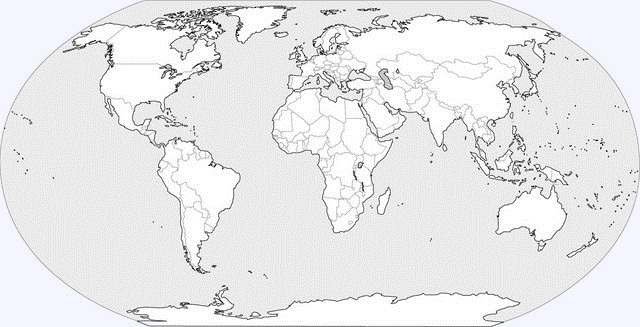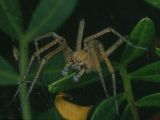|
Nombre común en ingles:
Meshweb spiders
Nombre común en castellano:
Se desconoce
Familias similares:
Género tipo:
Dictyna Sundevall, 1833
Diagnosis:
Small araneomorph spiders; three
tarsal claws; cribellate or cribellum reduced; entelegyne; six or
eight eyer; calamistrum uniseriate; cribellum wide; endites
converging; branched tracheae.
Caracteres descriptivos:
Caparazón: cephalic region usually relatively high;
with longitudinal rows of white setae (Dictyninae);
pear-shaped without setae (Tricholathysinae); fovea reduced.
Esternón: triangular. Ojos: eight or six (anterior median eyes reduced in
Cicurininae); either all, or only anterior median eyes dark.
Quelíceros: vertical; modified (curved) in males of
some genera. Piezas bucales: endites converging. Patas: three claws; legs of moderate length; tarsi
either without or with one or two rows of trichobothria;
legs usually without true spines; trichobothria reduced. Abdomen: suboval to oval and elongate
(Tricholathysinae); slightly overlapping carapace; bearing
dense layer of setae; usually with pattern. Hileras: six; cylindrical; anterior and posterior
spinnerets two-segmented; distal segments short. Cribellum: bipartite or entire (reduced in
Cicurininae). Calamistrum: uniseriate. Sistema respiratorio: two booklungs; posterior
tracheal spiracle broad, open close to spinnerets. Genitalia: entelegyne; epigyne weakly sclerotized;
male palp usually without median apophysis; embolus long and
slender; conductor directed backwards; tibial apophyses
present. Tamaño corporal: <5 mm. Color: varies from greenish to pale to dark brown or
grey; abdomen usually pale with dark patter.
Estatus taxonómico:
The limits of the family as defined by Simon were modifired
(Lehtinen, 1967) and the position of certain genera is still
provisional. Coddington & Levi (1991) and Coddington et al. (2004)
placed the Dictynidae in the superfamily Dictynoidea of the 'RTA
clade'. However, they stated that the placement of families in the
Dictynoidea and Amaurobioidea continues more out of tradition than
because of strong synapomorphies. Lehtinen (1967) provided
diagnostic characters for some genera. Chamberlin & Ivie (1941)
reviewed the New World Cicurina, Chamberlin & Gertsch (1958) revised
the cribellate species in North America.
Distribución: Worldwide;
more common in temperate regions than in the tropics.

Estilo de vida: Life style
varies. Dictyninae: plant-dwelling spiders constructing a web with
paralled threads crisscrossed with cribellate silk to form a
ladder-like structure or mesh-like retreat webs on plant; some
species are kleptoparasites; Cicurininae and Tricholathysinae are
ground-dwellers; some species are found in the intertidial zone.
Bibliografía:
-
Bennett, R.G. 2005b. Dictynidae. pp. 95-101 in Ubick, D., Paquin,
P., Cushing, P.E. & Roth, V. (Eds) 2005. The Spiders of North
America. An Identification Manual. American Arachnological Society.
-
Chamberlin, R.V. & Gertsch, W.J. 1958. The spider family Dictynidae
in America north of Mexico. Bull. Am. Mus. nat. Hist. 116: 1-152.
-
Chamberlin, R.V. & Ivie, W. 1940. Agelenid spiders of the genus
Cicurina. Bull. Univ. Utah 30: 1-108.
-
Dippenaar-Schoeman, A.S. & Jocqué, R. 1997. African Spiders: An
Identification Manual. Plant Protection Res. Inst. Handbook, no. 9,
Pretoria, 392 pp.
-
Forster, R.R. 1970. The spiders of New Zealand. Part III. Otago Mus.
Bull. 3: 1-184.
-
Gertsch, W.J. 1992. Distribution patterns and speciation in North
American cave spiders with a list of the troglobites and revision of
the cicurinas of the cicurinas of the subgenus Cicurella. Texas mem.
Mus. speleol. Monogr. 3: 75-122.
-
Lehtinen, P.T. 1967. Classification of the cribellate spiders and
some allied families, with notes on the evolution of the suborder
Araneomorpha. Ann. Zool. Fenn. 4: 199-468.
11 géneros y 24 especies presentes en la Península Ibérica:
|
| |
- A. lucida
(Simon, 1874) |
|
| |
- A.
consecuta
(O. P.-Cambridge, 1872) |
|
| |
- A.
subnigra
(O. P.-Cambridge, 1861) |
|
| |
- C. maritimus
Simon, 1884 |
|
| |
- C. subterraneum
Simon, 1872 |
|
| |
- D. arundinacea
(Linnaeus, 1758) |
| |
- D. civica
(Lucas, 1850) |
| |
- D. kosiorowiczi
Simon, 1873 |
| |
- D. latens
(Fabricius, 1775) |
| |
- D. uncinata
Thorell, 1856 |
|
| |
- L. affinis
(Blackwall, 1862) |
| |
- L. heterophthalma
Kulczynski, 1891 |
| |
- L. humilis
(Blackwall, 1855) |
| |
- L. jubata
(Denis, 1947) |
| |
- L. lepida
O. P.-Cambridge, 1909 |
| |
- L. narbonensis
(Simon, 1876) |
|
| |
- M. bicolor
(Simon, 1870) |
|
| |
- M. arietina
(Thorell, 1871) |
|
| |
- N. flavescens
(Walckenaer, 1830) |
| |
- N. gratiosa
(Simon, 1881) |
| |
- N. hortensis
(Simon, 1870) |
| |
- N. puella
(Simon, 1870) |
| |
- N. walckenaeri
(Roewer, 1951) |
|
| |
- S. simplex
Simon, 1884 |
| |
|
 |